This is a retrospective overview recounting my early
experiences as regards computers, Ataris, videogames, etc. and I hope it
will be of some interest. It is personal - and I'd like to give thanks
to Andrew Bradfield for being there at the right time, so that we were
able to do something we never previously thought possible.
I live in Dunedin, New Zealand - it is a small,
compact modern city that's probably much the same as others in this
modern western world.
The 70s
I can't recall having much of an early interest in
computers, not knowing much about the subject growing up - in the early
1970s at high school, there were no computers around. My interest then
was in still photography, having first purchased a very cheap camera,
and then buying something more and more expensive and capable
(sounds like a PC?). Drawing was an interest I had for a long time - I
did draw some local buildings around town - though while I did draw some
sketches on location, I preferred using photographs. Photography became
my central interest.
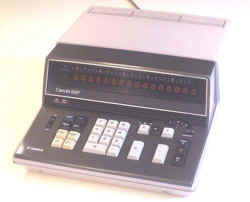
An early
Canon calculator
Computers were not around, but at a local winter show,
Canon had on display their desktop calculators with LED read-out - interesting to play with, although they were difficult to access
because of other children around wanting to do the same. Wow, playing
around with numbers, I wonder if the others had the same fascination?
Mathematics was a subject I did extremely well in - I don't know why.
When we started having marks for terms etc. mathematics was always my
best subject. Being placed first in my class, in the first term of high
school was a surprise that shocked everyone, including me!
I only attended high school to the sixth form and did
not go onto university, mainly because of money reasons, and I did not
have the desire for further study. I eventually got a job as a
window dresser with a local department store - the varied work made it
interesting. Then I went onto work in a colour film processing
laboratory. I had hoped this would be a permanent situation but I
didn't fit in well with the management there, and left voluntarily for
peace of mind, and health. Thereafter I worked at two factory jobs for a
while, then studied a one year polytechnic course that was supposed to
prepare you as a prospective employee for the data processing industry.
I studied communications, English, accounting, keyboard skills (I acquired
these on my own, previously having self taught myself from a
basic typing guide, using a typewriter), programming (BASIC and COBOL -
I wasn't much good at either) and a general introduction to the data
processing field.
The 80s
In the early 80s I remember going along to the Physics
department of the local university, and seeing some personal computers
up and running. I think the classic Star Trek game was running,
which was just using text, running on a Pet (?) computer. A ZX-80 was
present but you weren't able to do much on that. While on the
Polytechnic course, I was looking at Personal Computing magazine at what computers were available in the UK. The Sharp computer
was advertised, but I didn't know if it would be any good. At the end of
the Polytechnic course I had arranged to go to the UK for a while for
personal reasons and saved up enough for the trip and to shop for a
computer as well. Not much was available in December 1981. The Atari
400/800 computers were available in Dunedin, but at a high price. I did
type in a few BASIC graphics demo programs from Compute! program listings
at the local computer shop, to try it out (I purchased my Atari
ST and Amiga from here, later on). I wasn't taken by the Apple II, because of
the green screen. I checked out computers wherever I could, on route to
London, then Northern England. I was briefly in LA - impressed by the
Vectrex - and missed out on seeing any computers there, but met Bjo
Trimble and Forest Ackerman.
It was out in Hammersmith, London, that I
finally decided upon the Atari 800 (which had dropped in price a little
at that time - I purchased a 410
tape recorder, with Shamus and Race In Space). The Vic-20 was no
competition despite the smiling face of William Shatner (I knew he was
lying in the advertisement) and the Apple II no match with the
graphics ability of Atari Computers. I wasn't about to try coping
with an Atari 400 keyboard, so the Atari 800 was the only logical and
expensive choice.
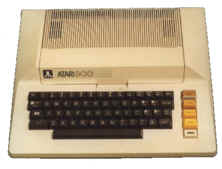
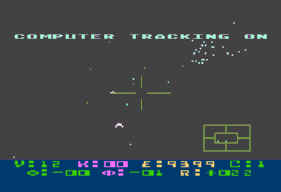
Atari
800 and Star
Raiders
There was nothing else that could touch Star Raiders -
so the superiority of Atari Computers was clearly shown.
Living in the UK
I ended up living in Northern England, Hull for about
10 months - not doing too much except getting familiar with my Atari
800. I made friends with the Staff family who were very helpful and
friendly. Harry Staff had an Atari 800 with 810 disk drive. I have to
confess that I got into copying computer games very early, mainly
because I did not have the money to purchase them.
I enjoyed playing the arcade games because of their
graphics and eye-hand coordination skill. The text adventures were nice
too - having to use your brain more.
Before I left I purchased an expensive Atari 810 disk
drive because tape loading and saving was always very slow and
unreliable. I was aware of the TV differences between the UK and New
Zealand, PAL A and PAL B respectively; UHF and VHF. I got Atari to
modify my Atari 800 before leaving.
A new partnership
After some months back home in New Zealand, Andrew
Bradfield was keen to meet me. His sister attended the local Science
Fiction meetings, which I attended also, and I had taken my computer
along to show them. He had an Atari 400 and was keen on any games I
might have. New Zealand Atari prices were pretty horrendous - there was a
mark-up with everything coming via Australia, via an Australian
distributor Ozisoft. Or was it Dick Smith? I was getting into drawing using Micropainter. Andrew was very much into
arcade game
conversions - he never played the coin-op arcade games, he would be
saving his money to buy the Atari game cartridges. He realised soon
enough it was getting too expensive. He was keen on programming his own
computer videogames. He tried out Atari BASIC to find out the language
was too slow for the kind of games he loved. I did get him a copy of
'The Arcade Game Machine' which was supposed to allow you to design your
own arcade game, but it wasn't well designed, nor versatile. Andrew
was just out of high school, and his only source of income was from an
after-school milk run. I got copied games sent out to me, from the UK.
The quality was amazing, as too the quantity!
Andrew realised that the only way for him to write his
own arcade games was to learn assembler language. He self taught
himself through a tutorial book - I think it was from Compute! Always
on hand with helpful advice was Todd Gramstrap - a local Atari
enthusiast whose first purchase was the Operating System manual for Atari computers. Todd could answer any question that Andrew had,
whether it was to do with assembler language, the Atari computers
graphics or operating system. Todd seemed to know almost anything.
Andrew quickly got into writing some very simple routines, so that by
his third little program he had a small game up and running. I believe
it took him only about a year to get ready to write Laser Hawk. It was
his own version of Tail of Beta Lyrae, a game that impressed him
(similarly Choplifter). Andrew designed Laser Hawk all by himself - it was initially
called Hot Copter. Red Rat came up with the flashier title of Laser
Hawk. I designed the graphics just before he needed them.
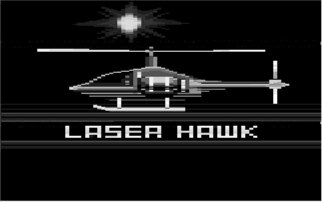
Laser Hawk by Andrew
Bradfield and Harvey Kong Tin
Andrew
always had a clear idea of what he wanted - he designed the title and
high score screens by himself. You can see he was impressed by
Boulderdash. We both felt the player should be rewarded for finishing
the level (or game), that's why the end of level (game) animation screen
was there. We felt strongly about continuity and a storyline, so that's
why the copter took off on it's mission, and why we had our
end-of-level targets.
We did things matter of factly, using common sense.
Hawkquest
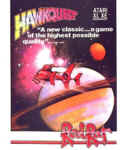 I'm to be blamed for the overall game design
of HawkQuest - insisting upon a grandiose game in scope, heavily influenced by Xevious, Gauntlet, Shamus and other games. I was playing
around with Fontbyter from Compute!, which allowed me to design
landscapes easily - without which HawkQuest would not have been
possible.
I'm to be blamed for the overall game design
of HawkQuest - insisting upon a grandiose game in scope, heavily influenced by Xevious, Gauntlet, Shamus and other games. I was playing
around with Fontbyter from Compute!, which allowed me to design
landscapes easily - without which HawkQuest would not have been
possible.
I made some test screens, which Todd Gramstrup has
kindly displayed scrolling - still a very nice graphics demo.
He scrolled down different landscape screens, along with different
re-defined character sets, and the join between the sets scrolled as if it was one.
I was never into programming - but the only program
I've written was my own version of the computer drawing different
subjects - like an Atari 800, 130XE, a portrait and a lighthouse (taken
from AtariArtist images). Other people can do likewise - take something
and change it, improve upon it. For instance, some people may recall
there's a really nice BASIC animation demo of a helicopter taking off.
This is from a book (I think the same one that has the hi-res drawing of
an Atari 400?). I did change it, so that it displays an Antic 4 graphic
of a helicopter. Someone could do it better, by using Paul Lay's
Graphics 9 character re-designer, to do a beautiful Graphics 9
helicopter.

Hawkquest by Andrew Bradfield
and Harvey Kong Tin
I've always ended up co-ordinating things, getting
involved with this or that.
I looked to see what editors were available for us to
use for Laser Hawk and HawkQuest - typing in listings, if necessary.
When Andrew saw something running in a game he would try to figure
out how it was done. e.g. with countdown numbers displayed while loading.
I'd type in graphics demos and let Andrew see them, to see if there was
something there he could use. I made contact with Paul Lay, and his
Graphics 9 character designer came in handy for use in HawkQuest. There
was always the problem of having too few players available (as in Player
Missile Graphics). Stewart Lees - a programmer living in Wellington whom I made contact
with - overcame this problem in his unfinished game. Once Andrew
saw it was possible, and was roughly shown the technique, he
wrote his own version that did the same thing. Stewart Lees was heavily
into Cyberstudio and the Atari ST. I think he got some work overseas in
that area?
I made all sort of contacts with Atari enthusiasts. One
was Graham Codd, known as 'Hack-Atari' - someone deeply involved with
hardware and software hacking.
Dunedin Atari User Group
I recall that the Dunedin Atari User Group started up
in the bedroom I was staying at, in 333 Castle Street. It
started with a few people - Graeme Wheeler, Todd, Andrew
and myself. These were the people and meetings which saw the development of
HawkQuest, in our spare time. It took a very long time: 3 years. Laser Hawk took only a year.
I eventually became president of the Dunedin Atari
User Group - but not a very effective one, because I was never one to
run things up front, always preferring behind the scenes. I was shy, quiet and
didn't like public speaking, etc. My presidency wasn't very effective or
long lasting. I did put out one and a half issues of the local Go
Atari! magazine, and managed to get various contributors involved, with some local sponsorship.
I was always at the Central City Computer Group
meetings - taking along my Atari 800 computer and showing it off
with all the latest demos and games. Eventually I took my Atari
ST, then later my Amiga 500.
Other Computers
With the decline of the Atari 8-bit computers, I got around to purchasing a used C-64 computer,
an
Action Replay cartridge and disk drive.
The C-64 was a very good computer for it's time. When
I first saw one running in England, there were few good games available
for it. By the time it got really popular the limits had been pushed far beyond
initial expectations. Wasn't it Paul Woakes who
first discovered how to make the C-64 turbo load off cassette such that
it was "smokin'"? Next there were turbo loaders which showed graphics and
played music while the game loaded. Having more independent hardware
sprites made the C-64 seemingly more capable than Atari computers
for arcade shoot 'em ups. Atari player missile graphics were
not as versatile, because of the limited number.
It was never an option for Andrew and myself to
develop for C-64 computers. We weren't sold on buying a C-64
computer and we didn't have access to anyone who knew anything about the
operating system, etc. While it required the same 6502 assembly language,
getting information about the hardware capabilities would not be easy. The
only reason to develop for the C-64 would be the huge market out there at the height of
its popularity.
Andrew and I were justifiably proud of having worked
on Laser Hawk and HawkQuest. I think we were the only people at the time who created and produced commercial computer games in New
Zealand. There was a retrospective display of computers at the local
Otago Early Settlers Museum last year, and Laser Hawk was shown
via an Atari 800 emulator running on a 386 PC. There were some graphic
glitches at the top of the display though. It was
sitting in a corner area with some text information. Around the large
display were an Apple II, a 2600 running Battlezone, and all manner of
archaic desktop and 'room' sized computers of the 60's and 70's, through
to the 80's.
Andrew went on from the Ataris to the Amiga, and learnt
68000 assembler. He was keen to write an Amiga game based around a
sideview of a man, with platform shooting. There were no editors
around, so he started writing one in assembler (he wasn't into high
level languages). Needless to say it took a great deal of time - a
project which didn't eventuate into something because it didn't look
like it would ever be completed. Andrew went from a keen arcade games player,
to programmer and back to games player - this time into strategy and
simulations.
We were always interested in hardware and video games
development, such as the Sega MegaDrive (Genesis) and
Super Nintendo, when these captured the mass market. Andrew enjoyed
playing "Legend of Zelda" on the Super Nintendo and
"Alien vs Predator" on the Atari Jaguar.
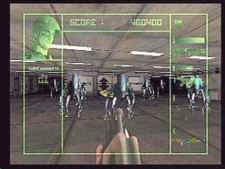
Alien vs Predator (Atari
Jaguar)
I purchased a 40MHz 486 PC around 1993. Andrew was
very keen on a Looking Glass 3D dungeon game at that time, and when Doom
appeared he was totally impressed by the technology and software. He was altogether convinced that the Amigas
were in their
decline and the total supremacy of the PC was obvious. He left arcade gaming to be more interested in simulations,
and 3D games to strategy games. He purchased a 300MHz PC and regularly
upgraded his PC every 2-3 years.
I was still firmly rooted in arcade games with their flash graphics.
I didn't have the time or interest to read through manuals before
playing a game. Andrew didn't mind doing that at all, as required with the complex
simulations and strategy games. He did like playing around with an
editor that allowed you to design your own architecture in which to go roaming around
- Unreal, or was it Quake? - and to set up puzzles
(like shooting things so as to make things fall into place, and open up new areas).
A Difficult Time
Andrew was in steady employment since he left High
School - working at a local engineering firm, as a sheet metal tradesman.
He attended some night classes at polytechnic as part of his
apprenticeship (around the time of HawkQuest). He was into sports
coupes, and purchased his first - a Subaru car - after working lots of
overtime. Part of his work was with welding, and he got qualified for
that. It is unfortunate that after many long years of hard work, he
developed leukaemia - which no one knows the cause of. Some of the work environments that Andrew worked
in would have been
none too healthy - doing factory upgrades, and a lot of welding.
After being diagnosed he was hopeful of being able
to have a bone marrow transplant, but that was not possible as the conditions/requirements to ensure that it would work for
him were not satisfied. He was accepted for the trial of a new drug,
Gleevec, that has worked wonders for
some leukaemia sufferers. He had to go over to Australia to be
on the drug treatment program, the first time he left the country. It
ended up not curing him, but helped him live an extra year.
Andrew was into driving fast cars, and had his Japanese import for
some time before he purchased a Porsche Boxster - his dream car - about a
month before his untimely death. He was a
confident and able fast driver. I didn't see that much of him as the
years passed by, and was taken out on only 2 spins in his fast cars.
It was sad that Andrew, a long time planner - especially with his finances -
suddenly had his life shortened. He
was very logical in his thinking. We would have very long
discussions about almost anything. Because of my long term interest in
the unexplained, I tried to prepare him for his journey. He had to live through a very difficult time,
and had to
accept what life had dealt him. I hope he understands now
what I had been trying to tell him.
?
The Unexplained
My real interest is in the unexplained - which you can call getting to
the truth of things (life, reality, etc.). Or call it an awareness of the
changing consciousness of this planet, which started in the late 1880s
and has been accelerating since the 1970s.
If you want the whole truth and nothing but the
truth, you have to re-examine everything because things are not as they
seem to be.
Religion and politics in particular come to mind. They
are concerned about 'power' and the control of power - distorting truth and facts
to retain this power. Religion is
distorted by power - the control of others (being the public) and those
directly under their control (the congregation). Sadly the major
religions have become 'establishments' and they seek first to keep
themselves in control.
It is said of a writer that they live and
breathe the words they write. If you examine
what is basically dogma and rhetoric - that which passes for religion,
and that is recalled endlessly by religious preachers - you
can see plainly in the text used, this isn't true at all. You can see a
message that is tainted and spun in such a way that it doesn't add up
to reason or logic, nor to its claims.
This is not to say that there isn't good in religions -
there's still good values mixed in with their distortions, if you can
recognise those which are good and decent human values, and those which
are not true.
I'm all for discussing things clearly, simply and
logically; to speak of things plainly and see the overall picture; that one piece of information supports another, and
another.
You can apply exactly the same techniques and reasoning
for everyday things as you can to religion and
politics - and insist upon truthful information. If necessary, kill
the messenger with ice cold logical words - if the message is distorted
and untrue. The more information you have, the
more convoluted the universe seems to be. It would be nice if there was
a simple answer to everything, but the more you know, the more you know
you do not know!
I can only say that truth is far stranger than any
science fiction. And what many people believe is true,
is just a story, made up for one reason or another.
Exactly what do I believe to be true and correct? I
will state plainly now. That everyone survives death, and that there is
life afterwards, even if you do not believe in it. That the human
body is animated by the human spirit within, and is ultimately released
from it - that one form of matter changes to another. There are so
many accounts and stories which support this view of the universe. The
information is out there. You can read, view or
listen to it.
Harvey Kong Tin, October 2003
top